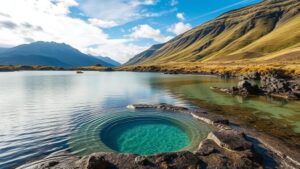Investigating the shifting icebergs of Jökulsárlón Glacier Lagoon in Iceland.
Investigating the Shifting Icebergs of Jökulsárlón Glacier Lagoon in Iceland
Jökulsárlón Glacier Lagoon, located in southeast Iceland, offers a unique glimpse into the profound effects of climate change as it showcases the magnificent yet alarming reality of glacier retreat and iceberg movement. Renowned for its breathtaking blue icebergs and serene beauty, the lagoon is both a natural wonder and a site for scientific investigation. This article delves into the dynamics of this stunning glacier lagoon, exploring its formation, the shifting icebergs, and the implications of these changes.
The Formation of Jökulsárlón
Jökulsárlón was formed during the past century due to the retreat of the Breiðamerkurjökull glacier, a part of the larger Vatnajökull glacier system. lagoon began to develop in the early 20th century, with significant expansion observed in the 1930s when the glacier began to melt more rapidly. By 2001, Jökulsárlón had grown to approximately 18 square kilometers (7 square miles), and it continues to expand.
Understanding Iceberg Movement
The icebergs in Jökulsárlón undergo continuous transformation and movement. Approximately 1,500 to 2,000 icebergs float in the lagoon at any given time, stemming from the calving process where chunks of ice break off from the glaciers edge. e icebergs vary in size, with some as small as a car while others can be several stories high.
The Climate Connection
The shifting icebergs of Jökulsárlón are a clear indicator of climate change. The average annual temperature in Iceland has risen by about 1.3°C (2.4°F) since the early 20th century. As a result, glaciers across the country, including Breiðamerkurjökull, are retreating at an accelerated pace. Research indicates that the glacier has lost around 500 meters (1,640 feet) in the last century, with a significant increase in ice loss observed since the turn of the millennium.
Scientific Investigations
Scientists are actively studying the changes occurring at Jökulsárlón to better understand the implications of glacial retreat on rising sea levels and global climate patterns. According to the Icelandic Meteorological Office, the melting glaciers contribute about 0.5 millimeters annually to global sea level rise. Monitoring programs involve satellite imagery and field studies that track shifts in ice mass and volume over time.
Visitor Impact and Opportunities
Tourism at Jökulsárlón has surged in recent years, drawing visitors from around the world eager to witness the beauty of the icebergs. lagoon has become a focal point for guided tours, photography, and even filming locations for movies such as Die Another Day and Interstellar. As tourism increases, it is crucial to ensure that visitors engage in responsible practices to preserve the natural environment.
Real-World Applications
Studying the icebergs of Jökulsárlón is not just about appreciating their beauty; it serves as a real-world example of glacial dynamics impacted by climate change. Understanding these processes helps inform global climate policy and encourages conservation efforts. Local initiatives, like guided eco-tours, educate visitors about the importance of glaciers and advocate for environmental responsibility.
Conclusion and Actionable Takeaways
As the icebergs of Jökulsárlón continue to shift and change, they symbolize the ongoing impact of climate change on our planet. By investigating these dynamic structures, scientists and visitors alike can gain valuable insights into the realities of our changing environment. To engage positively with this natural wonder, visitors should:
- Participate in guided tours that emphasize environmental education.
- Practice Leave No Trace principles to minimize human impact.
- Support local conservation efforts through donations or volunteering.
Through these actions, we can help preserve the pristine beauty of Jökulsárlón while contributing to broader efforts in climate awareness and environmental stewardship.



